Geometric and Kinematic Analyses and Novel Characteristics of Origami-Inspired Structures
Abstract
1. Introduction
2. Design Method of a Crease Pattern
2.1. Mathematical Theory for Origami Design
- (a)
- Given two points of P1 and P2, we can make a crease over P1 and P2;
- (b)
- Given two points of P1 and P2, we can fold P1 onto P2 along a crease to make the two points coincide;
- (c)
- Given two straight lines L1 and L2, we can fold line L1 onto L2 along a crease to make the two lines coincide;
- (d)
- Given a point P1 and a line L1, we can fold line L1 onto itself along a crease passing through point P1;
- (e)
- Given two points P1 and P2 and a line L1, we can fold point P1 onto line L1 along a crease passing through point P2;
- (f)
- Given two points P1 and P2 and two lines L1 and L2, we can fold P1 and P2 onto L1 and L2, respectively, along a crease; and
- (g)
- Given a point P and two lines L1 and L2, we can fold point P onto line L1 along a crease perpendicular to L2.
2.2. Common Crease Patterns
2.3. Design of Crease Patterns
3. Kinematic Analysis of Origami-Inspired Structures
3.1. Rigid Folding of Origami
3.2. Large Deformations of Origami Structures
3.3. Kinematic Singularity and Potential Bifurcation of Origami Structures
- (a)
- Set the initial iteration step size to , as the ideal structure moves along the unique motion path before singularity. is the maximum size of the members. Set the initial value of to , and denotes the entry of the r-th row and r-th column in the singular matrix .
- (b)
- In each iteration, the generalized displacement compatibility matrix J of the structure can be obtained according to the geometric configuration of the iteration step , and the corresponding minimum nonzero singular value can be obtained.
- (c)
- The size of iteration step is determined by . When , the minimum nonzero singular value decreases and approaches zero; take to avoid crossing singularities. is the maximum number of iteration steps. When , it moves away from singularities, take to accelerate the solution process.
- (d)
- After determining the size of , the motion path can be tracked and the configuration can be updated according to the nonlinear prediction-correction method.
- (e)
- When t is greater than the maximum number of iteration steps , the configuration is singular and the iteration ends.
4. Novel Characteristics of Origami Structures
Recongifurable Stiffness and Configuration
5. Discussion
6. Conclusions
Author Contributions
Funding
Conflicts of Interest
References
- Chen, Y.; Feng, J. Group-Theoretic Exploitations of Symmetry in Novel Prestressed Structures. Symmetry 2018, 10, 229. [Google Scholar] [CrossRef]
- Turner, N.; Goodwine, B.; Sen, M. A Review of Origami Applications in Mechanical Engineering. Proc. Inst. Mech. Eng. Part C J. Mech. Eng. Sci. 2015, 230, 2345–2362. [Google Scholar] [CrossRef]
- Chen, Y.; You, Z. Square Deployable Frames for Space Applications. Part 1: Theory. Proc. Inst. Mech. Eng. Part G J. Aerosp. Eng. 2006, 220, 347–354. [Google Scholar] [CrossRef]
- Chen, Y.; Sareh, P.; Feng, J. Effective Insights into the Geometric Stability of Symmetric Skeletal Structures under Symmetric Variations. Int. J. Solids Struct. 2015, 69, 277–290. [Google Scholar] [CrossRef]
- Cheng, Q.; Song, Z.; Ma, T.; Smith, B.B.; Tang, R.; Yu, H.; Jiang, H.; Chan, C.K. Folding Paper-Based Lithium-Ion Batteries for Higher Areal Energy Densities. Nano Lett. 2013, 13, 4969–4974. [Google Scholar] [CrossRef]
- Azam, A.; Laflin, K.E.; Jamal, M.; Fernandes, R.; Gracias, D.H. Self-Folding Micropatterned Polymeric Containers. Biomed. Microdevices 2011, 13, 51–58. [Google Scholar] [CrossRef] [PubMed]
- Randall, C.L.; Leong, T.G.; Bassik, N.; Gracias, D.H. 3D Lithographically Fabricated Nanoliter Containers for Drug Delivery. Adv. Drug Deliv. Rev. 2007, 59, 1547–1561. [Google Scholar] [CrossRef] [PubMed]
- Kuribayashi, K.; Tsuchiya, K.; You, Z.; Tomus, D.; Umemoto, M.; Ito, T.; Sasaki, M. Self-Deployable Origami Stent Grafts as a Biomedical Application of Ni-Rich Tini Shape Memory Alloy Foil. Mater. Sci. Eng. A. Struct. 2006, 419, 131–137. [Google Scholar] [CrossRef]
- Eidini, M.; Paulino, G.H. Unraveling Metamaterial Properties in Zigzag-Base Folded Sheets. Sci. Adv. 2015, 1, e1500224. [Google Scholar] [CrossRef] [PubMed]
- Kamrava, S.; Mousanezhad, D.; Ebrahimi, H.; Ghosh, R.; Vaziri, A. Origami-Based Cellular Metamaterial with Auxetic, Bistable, and Self-Locking Properties. Sci. Rep. 2017, 7, 46046. [Google Scholar] [CrossRef]
- Felton, S.; Tolley, M.; Demaine, E.; Rus, D.; Wood, R. A Method for Building Self-Folding Machines. Science 2014, 345, 644. [Google Scholar] [CrossRef] [PubMed]
- Mu, J.; Hou, C.; Wang, H.; Li, Y.; Zhang, Q.; Zhu, M. Origami-Inspired Active Graphene-Based Paper for Programmable Instant Self-Folding Walking Devices. Sci. Adv. 2015, 1, e1500533. [Google Scholar] [CrossRef] [PubMed]
- Tremblay, E.J.; Stack, R.A.; Morrison, R.L.; Ford, J.E. Ultrathin Cameras using Annular Folded Optics. Appl. Optics. 2007, 46, 463–471. [Google Scholar] [CrossRef] [PubMed]
- Jeong-Hyun, C.; Keung, M.D.; Niels, V.; Liesbet, L.; Moshchalkov, V.V.; Pol, V.D.; Gracias, D.H. Nanoscale Origami for 3D Optics. Small 2011, 7, 1943–1948. [Google Scholar]
- Cybulski, J.S.; Clements, J.; Prakash, M. Foldscope: Origami-Based Paper Microscope. PLoS ONE 2014, 9, e98781. [Google Scholar] [CrossRef] [PubMed]
- Miura, K. Method of Packaging and Deployment of Large Membranes in Space. Inst. Space Astronaut. Sci. Rep. 1985, 618, 1–10. [Google Scholar]
- Miura, K. Folded Map and Atlas Design Based on the Geometric Principle. In Proceedings of the 20th International Cartographic Conference: Mapping the 21st Century, Beijing, China, 6–10 August 2001. [Google Scholar]
- Chen, Y.; Feng, J.; Liu, Y. A Group-Theoretic Approach to the Mobility and Kinematic of Symmetric Over-Constrained Structures. Mech. Mach. Theory 2016, 105, 91–107. [Google Scholar] [CrossRef]
- Song, Z.; Ma, T.; Tang, R.; Cheng, Q.; Wang, X.; Krishnaraju, D.; Panat, R.; Chan, C.K.; Yu, H.; Jiang, H. Origami Lithium-Ion Batteries. Nat. Commun. 2014, 5, 3140. [Google Scholar] [CrossRef] [PubMed]
- Nam, I.; Kim, G.; Park, S.; Han, J.W.; Yi, J. All-Solid-State, Origami-Type Foldable Supercapacitor Chips with Integrated Series Circuit Analogues. Energy Environ. Sci. 2014, 7, 1095–1102. [Google Scholar] [CrossRef]
- Alshakim, N.; Belitsky, J.M.; Sébastien, V.; C. Steven, J.; Baum, L.G.; J. Fraser, S. A Self-Assembled Multivalent Pseudopolyrotaxane for Binding Galectin-1. J. Am. Chem. Soc. 2004, 126, 11914–11922. [Google Scholar]
- Randall, C.L.; Gultepe, E.; Gracias, D.H. Self-Folding Devices and Materials for Biomedical Applications. Trends Biotechnol. 2012, 30, 138–146. [Google Scholar] [CrossRef] [PubMed]
- Silverberg, J.L.; Evans, A.A.; Mcleod, L.; Hayward, R.C.; Hull, T.; Santangelo, C.D.; Cohen, I. Using Origami Design Principles to Fold Reprogrammable Mechanical Metamaterials. Science 2014, 345, 647. [Google Scholar] [CrossRef] [PubMed]
- Bern, M.; Hayes, B. The Complexity of Flat Origami. In Proceedings of the SODA’96, Philadelphia, PA, USA, 28 January 1996; pp. 175–183. [Google Scholar]
- Fei, L.J.; Sujan, D. Origami Theory and its Applications: A Literature Review. Int. J. Soc. Hum. Sci. Eng. 2013, 7, 113–117. [Google Scholar]
- Marcellini, P.; Paolini, E. Origami and Partial Differential Equations. Not. Am. Math. Soc. 2012, 57, 241–250. [Google Scholar]
- Lebée, A. From Folds to Structures, a Review. Int. J. Space Struct. 2016, 30, 55–74. [Google Scholar] [CrossRef]
- Hanna, B.H.; Lund, J.M.; Lang, R.J.; Magleby, S.P.; Howell, L.L. Waterbomb Base: A Symmetric Single-Vertex Bistable Origami Mechanism. Smart Mater. Struct. 2014, 23, 94009. [Google Scholar] [CrossRef]
- Yoshimura, Y. On the Mechanism of Buckling of a Circular Cylindrical Shell Under Axial Compression. Rep. Inst. Sci. Technol. Univ. Tokyo 1955, 5, 179–198. [Google Scholar]
- Hunt, G.W.; Ario, I. Twist Buckling and the Foldable Cylinder: An Exercise in Origami. Int. J. Non-Linear Mech. 2005, 40, 833–843. [Google Scholar] [CrossRef]
- Evans, T.A.; Lang, R.J.; Magleby, S.P.; Howell, L.L. Rigidly Foldable Origami Gadgets and Tessellations. R. Soc. Open Sci. 2015, 2, 150067. [Google Scholar] [CrossRef]
- Sareh, P.; Guest, S.D. Design of Non-Isomorphic Symmetric Descendants of the Miura-Ori. Smart Mater. Struct. 2015, 24, 085002. [Google Scholar] [CrossRef]
- Sareh, P. Symmetric Descendants of the Miura-ori. Ph.D. Thesis, Engineering Department, University of Cambridge, Cambridge, UK, 2014. [Google Scholar]
- Sareh, P.; Guest, S.D. Design of isomorphic symmetric descendants of the Miura-ori. Smart Mater. Struct. 2015, 24, 085001. [Google Scholar] [CrossRef]
- Sareh, P.; Guest, S.D. A Framework for the Symmetric Generalisation of the Miura-ori. Int. J. Space Struct. 2015, 30, 141–152. [Google Scholar] [CrossRef]
- Lang, M.R.; Photographer, R. The Complete Book of Origami: Step-by-Step Instructions in over 1000 Diagrams/37 Original Models; Dover Publications: New York, NY, USA, 2013. [Google Scholar]
- Demaine, E.D.; O’Rourke, J. Geometric Folding Algorithms: Linkages, Origami, Polyhedra; Cambridge University Press: Cambridge, UK, 2008. [Google Scholar]
- Belcastro, S.M.; Hull, T.C. Modelling the Folding of Paper into Three Dimensions Using Affine Transformations. Linear Algebra Appl. 2002, 348, 273–282. [Google Scholar] [CrossRef]
- Tachi, T. Generalization of Rigid Foldable Quadrilateral Mesh Origami. J. Int. Assoc. Shell Spat. Struct. 2009, 50, 173–179. [Google Scholar]
- Wu, W.; You, Z. Modelling Rigid Origami with Quaternions and Dual Quaternions. Proc. R. Soc. A. Math. Phys. 2010, 466, 2155–2174. [Google Scholar] [CrossRef]
- Zhou, X.; Wang, H.; Zhong, Y. Design of Three-Dimensional Origami Structures Based on a Vertex Approach. Proc. R. Soc. A. Math. Phys. 2015, 471, 20150407. [Google Scholar] [CrossRef]
- Chen, Y.; Sareh, P.; Yan, J.Y.; Fallah, A.S.; Feng, J. An Integrated Geometric-Graph-Theoretic Approach to Representing Origami Structures and their Corresponding Truss Frameworks. J. Mech. Des. 2019, 141, 091402. [Google Scholar] [CrossRef]
- Chen, Y.; Sareh, P.; Feng, J.; Sun, Q.Z. A Computational Method for Automated Detection of Engineering Structures with Cyclic Symmetries. Comput. Struct. 2017, 191, 153–164. [Google Scholar] [CrossRef]
- Hangai, Y. Application of the Generalized Inverse to the Geometrically Nonlinear Problem. Solid Mech. Arch. 1981, 6, 129–165. [Google Scholar]
- Schenk, M.; Guest, S.D. Geometry of Miura-Folded Metamaterials. Proc. Natl. Acad. Sci. USA 2013, 110, 3276–3281. [Google Scholar] [CrossRef]
- Chen, Y.; Feng, J. Improved Symmetry Method for The Mobility of Regular Structures using Graph Products. J. Struct. Eng. 2016, 142, 04016051. [Google Scholar] [CrossRef]
- Gioia, F.; Dureisseix, D.; Motro, R.; Maurin, B. Design and Analysis of a Foldable/Unfoldable Corrugated Architectural Curved Envelop. J. Mech. Des. 2012, 134, 031003. [Google Scholar] [CrossRef]
- Sareh, P.; Chermprayong, P.; Emmanuelli, M.; Nadeem, H.; Kovac, M. A Rotary Origami Protective System for Robotic Rotorcraft. Sci. Robot. 2018, 3, h5228. [Google Scholar] [CrossRef]
- Wei, G.W.; Dai, J.S. Origami-Inspired Integrated Planar-Spherical Overconstrained Mechanisms. J. Mech. Des. 2014, 136, 051003. [Google Scholar] [CrossRef]
- Huffman, D.A. Curvature and Creases: A Primer on Paper. IEEE Trans. Comput. 1976, C-25, 1010–1019. [Google Scholar] [CrossRef]
- Mentrasti, L. Rigid Folding Representation by the Stereographic Projection. Mech. Mach. Theory 2015, 86, 281–295. [Google Scholar] [CrossRef]
- Zhang, T.; Kawaguchi, K.; Wu, M. A Folding Analysis Method for Origami Based on the Frame with Kinematic Indeterminacy. Int. J. Mech. Sci. 2018, 146, S78757008. [Google Scholar] [CrossRef]
- Zhao, J.S.; Wang, J.Y.; Chu, F.; Feng, Z.J.; Dai, J.S. Structure Synthesis and Statics Analysis of a Foldable Stair. Mech. Mach. Theory 2011, 46, 998–1015. [Google Scholar] [CrossRef]
- Ding, X.; Yang, Y.; Dai, J.S. Design and Kinematic Analysis of a Novel Prism Deployable Mechanism. Mech. Mach. Theory 2013, 63, 35–49. [Google Scholar] [CrossRef]
- Cai, J.; Qian, Z.; Jiang, C.; Feng, J.; Xu, Y. Mobility and Kinematic Analysis of Foldable Plate Structures Based on Rigid Origami. J. Mech. Robot. 2016, 8, 064502. [Google Scholar] [CrossRef]
- Chen, Y.; Fan, L.; Feng, J. Kinematic of Symmetric Deployable Scissor-Hinge Structures with Integral Mechanism Mode. Comput. Struct. 2017, 191, 140–152. [Google Scholar] [CrossRef]
- Chen, Y.; Feng, J. Generalized Eigenvalue Analysis of Symmetric Prestressed Structures using Group Theory. J. Comput. Civ. Eng. 2012, 26, 488–497. [Google Scholar] [CrossRef]
- Gattas, J.M.; Wu, W.; You, Z. Miura-Base Rigid Origami: Parameterizations of First-Level Derivative and Piecewise Geometries. J. Mech. Des. 2013, 135, 111011. [Google Scholar] [CrossRef]
- Silverberg, J.L.; Jun-Hee, N.; Evans, A.A.; Bin, L.; Hull, T.C.; Santangelo, C.D.; Lang, R.J.; Hayward, R.C.; Itai, C. Origami Structures with a Critical Transition to Bistability Arising from Hidden Degrees of Freedom. Nat. Mater. 2015, 14, 389–393. [Google Scholar] [CrossRef] [PubMed]
- Chen, Y.; Feng, J. Folding of a Type of Deployable Origami Structures. Int. J. Struct. Stab. Dyn. 2012, 12, 1250054. [Google Scholar] [CrossRef]
- Zhou, C.; Wang, B.; Ma, J.; You, Z. Dynamic Axial Crushing of Origami Crash Boxes. Int. J. Mech. Sci. 2016, 118, 1–12. [Google Scholar] [CrossRef]
- Filipov, E.T.; Liu, K.; Tachi, T.; Schenk, M.; Paulino, G.H. Bar and Hinge Models for Scalable Analysis of Origami. Int. J. Solids Struct. 2017, 124, 26–45. [Google Scholar] [CrossRef]
- Liu, K.; Paulino, G.H. Nonlinear Mechanics of Non-Rigid Origami: An Efficient Computational Approach. Proc. R. Soc. A. Math. Phys. 2017, 473, 20170348. [Google Scholar] [CrossRef]
- Friedman, N.; Weiner, M.; Farkas, G.; Hegedűs, I.; Ibrahimbegovic, A. On the Snap-Back Behavior of a Self-Deploying Antiprismatic Column during Packing. Eng. Struct. 2013, 50, 74–89. [Google Scholar] [CrossRef]
- Chen, Y.; Feng, J.; Sun, Q.Z. Lower-Order Symmetric Mechanism Modes and Bifurcation Behavior of Deployable Bar Structures with Cyclic Symmetry. Int. J. Solids Struct. 2018, 139, 1–14. [Google Scholar] [CrossRef]
- Lengyel, A.; You, Z. Bifurcations of Sdof Mechanisms using Catastrophe Theory. Int. J. Solids Struct. 2004, 41, 559–568. [Google Scholar] [CrossRef]
- Kumar, P.; Pellegrino, S. Computation of Kinematic Paths and Bifurcation Points. Int. J. Solids Struct. 2000, 37, 7003–7027. [Google Scholar] [CrossRef]
- Gan, W.W.; Pellegrino, S. Numerical Approach to the Kinematic Analysis of Deployable Structures Forming a Closed Loop. Proc. Inst. Mech. Eng. Part C J. Mech. Eng. Sci. 2006, 220, 1045–1056. [Google Scholar] [CrossRef]
- Menaut, R.; Chen, B.G.; van Hecke, M.; Waitukaitis, S. Origami Multistability: From Single Vertices to Metasheets. Phys. Rev. Lett. 2015, 114, 55503. [Google Scholar]
- Overvelde, J.T.; de Jong, T.A.; Shevchenko, Y.; Becerra, S.A.; Whitesides, G.M.; Weaver, J.C.; Hoberman, C.; Bertoldi, K. A Three-Dimensional Actuated Origami-Inspired Transformable Metamaterial with Multiple Degrees of Freedom. Nat. Commun. 2016, 7, 10929. [Google Scholar] [CrossRef] [PubMed]
- You, Z. Folding Structures Out of Flat Materials. Science 2014, 345, 623. [Google Scholar] [CrossRef] [PubMed]
- Fathers, R.K.; Gattas, J.M.; You, Z. Quasi-Static Crushing of Eggbox, Cube, and Modified Cube Foldcore Sandwich Structures. Int. J. Mech. Sci. 2015, 101, 421–428. [Google Scholar] [CrossRef]
- Ma, J.; Hou, D.; Yan, C.; You, Z. Quasi-Static Axial Crushing of Thin-Walled Tubes with a Kite-Shape Rigid Origami Pattern: Numerical Simulation. Thin Wall. Struct. 2016, 100, 38–47. [Google Scholar] [CrossRef]
- Fernandes, R.; Gracias, D.H. Self-Folding Polymeric Containers for Encapsulation and Delivery of Drugs. Adv. Drug Deliv. Rev. 2012, 64, 1579–1589. [Google Scholar] [CrossRef] [PubMed]
- Khattiya, C.; Nikolai, C.; Hua, J.; Jian, L.; Babak, P.; Paraoanu, G.S. Self-Organized Origami Structures Via Ion-Induced Plastic Strain. Adv. Mater. 2013, 25, 91–95. [Google Scholar]
- Pinson, M.B.; Stern, M.; Ferrero, A.C.; Witten, T.A.; Chen, E.; Murugan, A. Self-Folding Origami at any Energy Scale. Nat. Commun. 2017, 8, 15477. [Google Scholar] [CrossRef]
- Wei, Z.Y.; Guo, Z.V.; Dudte, L.; Liang, H.Y.; Mahadevan, L. Geometric Mechanics of Periodic Pleated Origami. Phys. Rev. Lett. 2013, 110, 325–329. [Google Scholar] [CrossRef]
- Yang, J.; Yasuda, H. Reentrant Origami-Based Metamaterials with Negative Poisson’s Ratio and Bistability. Phys. Rev. Lett. 2015, 114, 185502. [Google Scholar]
- Zhang, X.; Cheng, G.; You, Z.; Zhang, H. Energy Absorption of Axially Compressed Thin-Walled Square Tubes with Patterns. Thin Wall. Struct. 2007, 45, 737–746. [Google Scholar] [CrossRef]

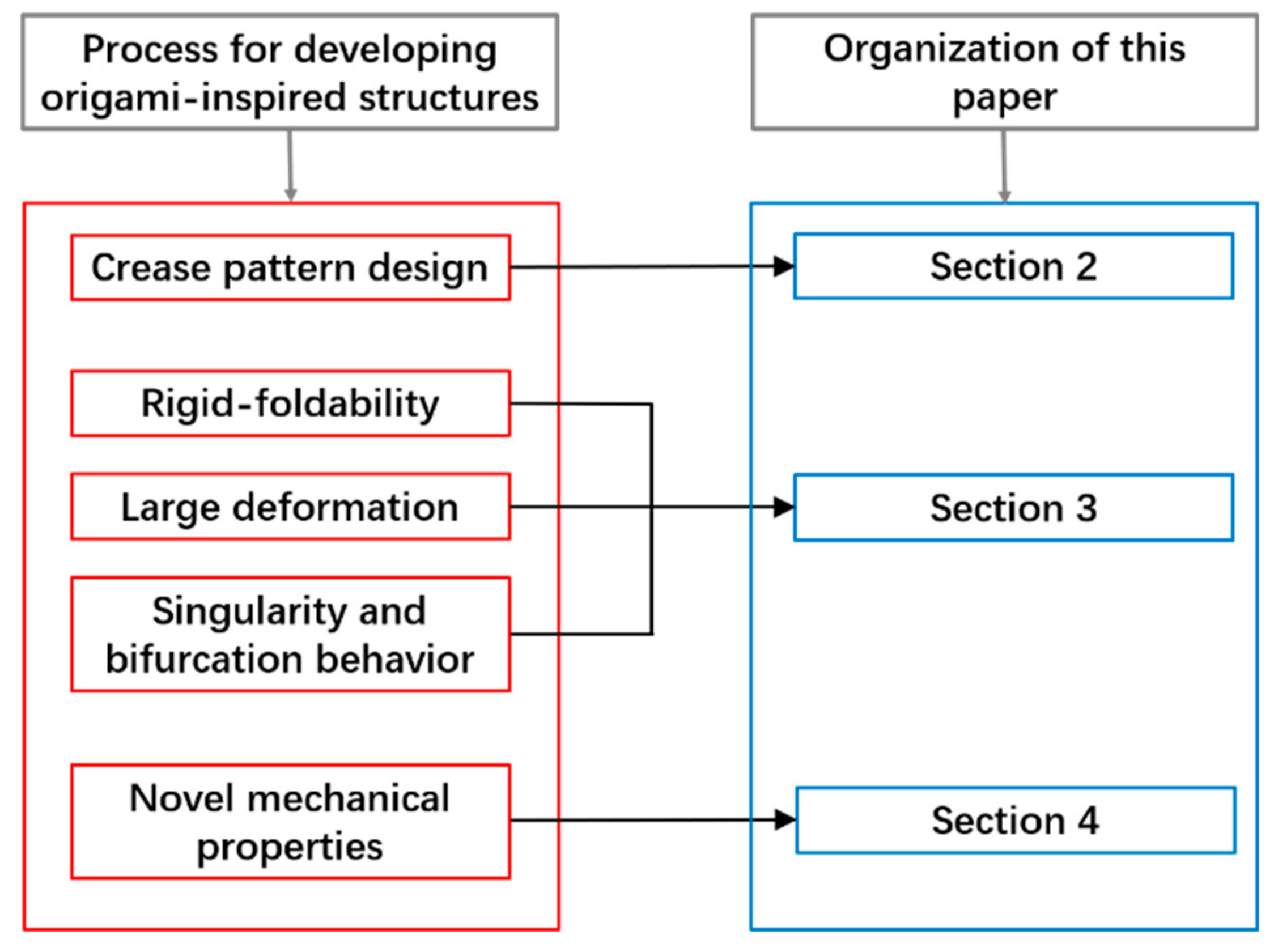
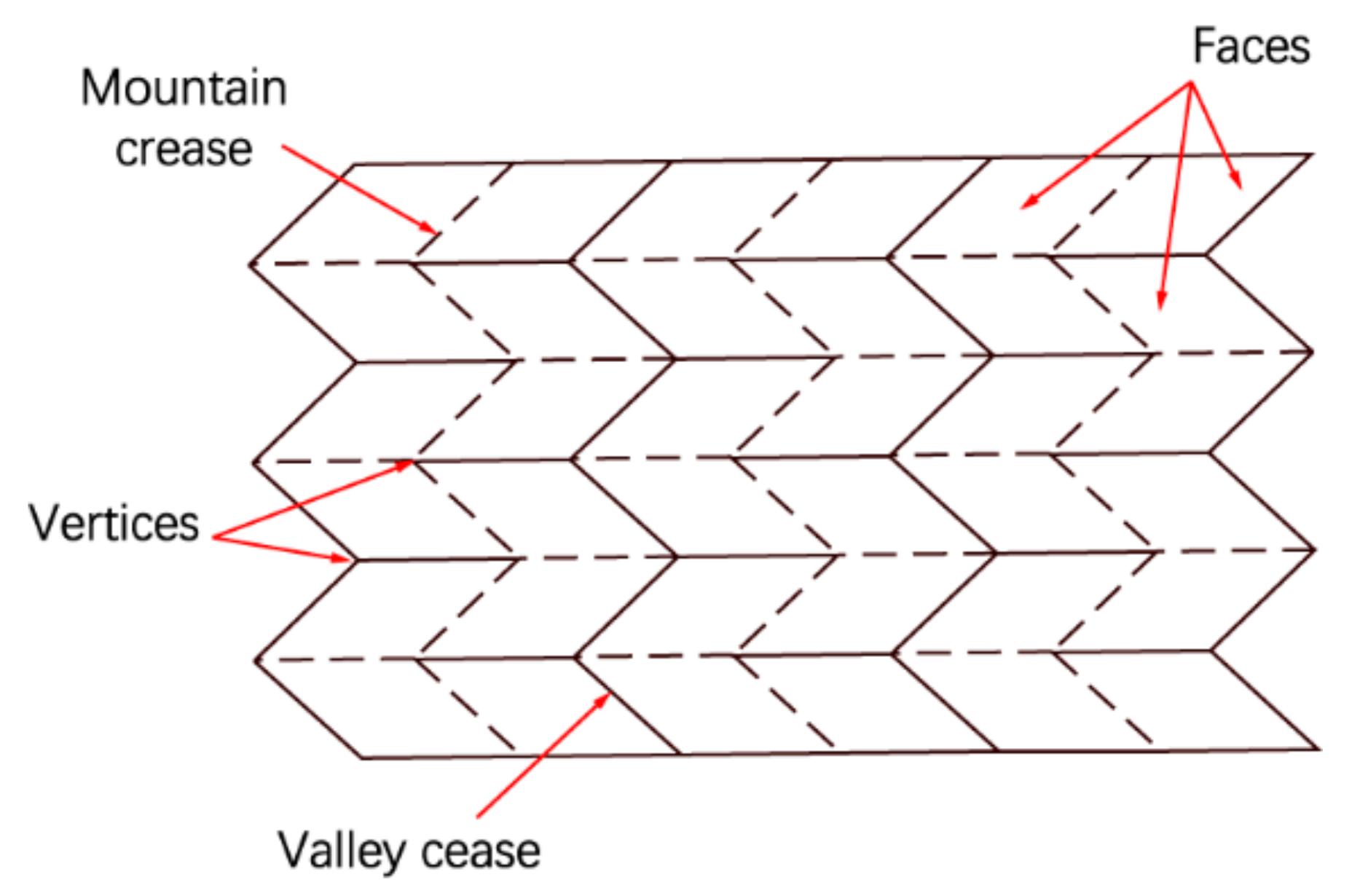
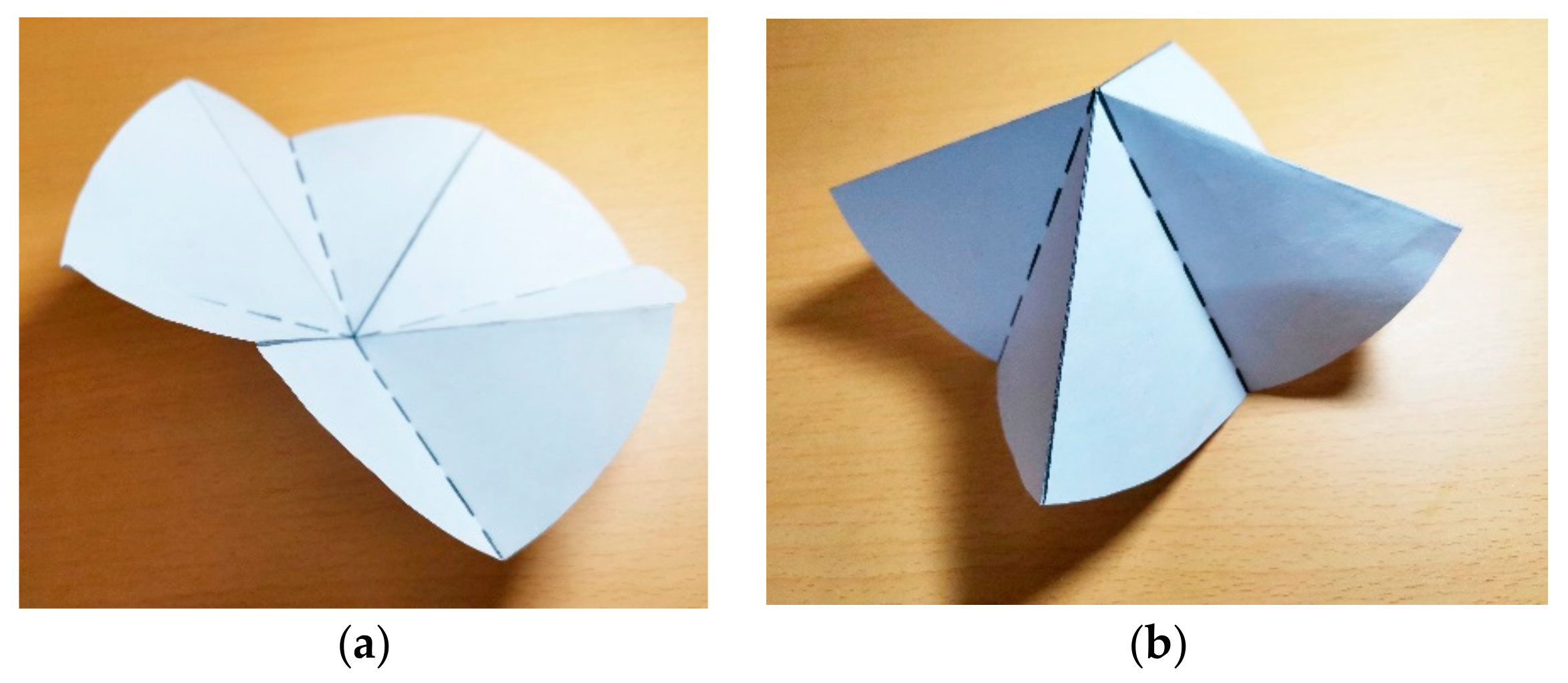
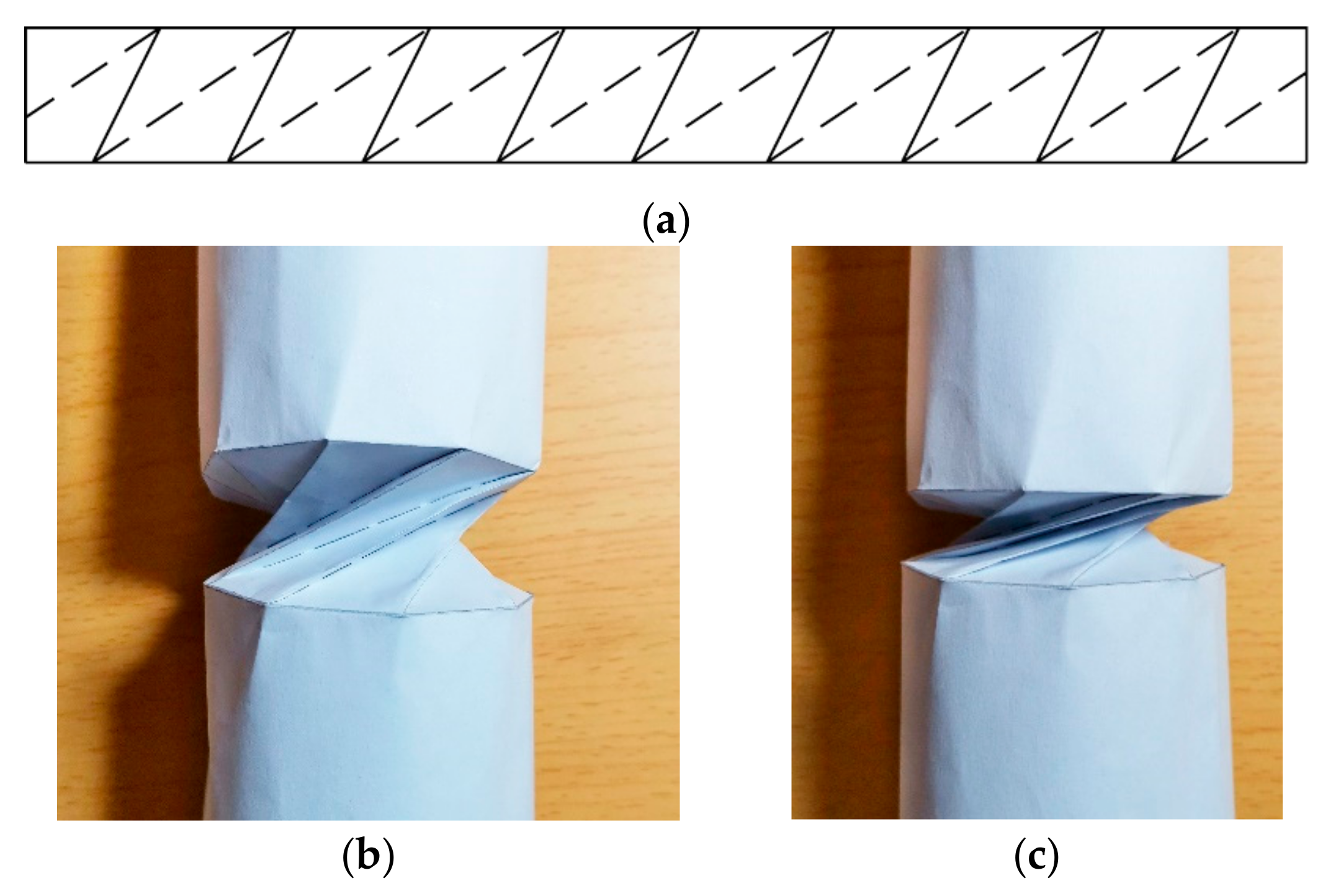
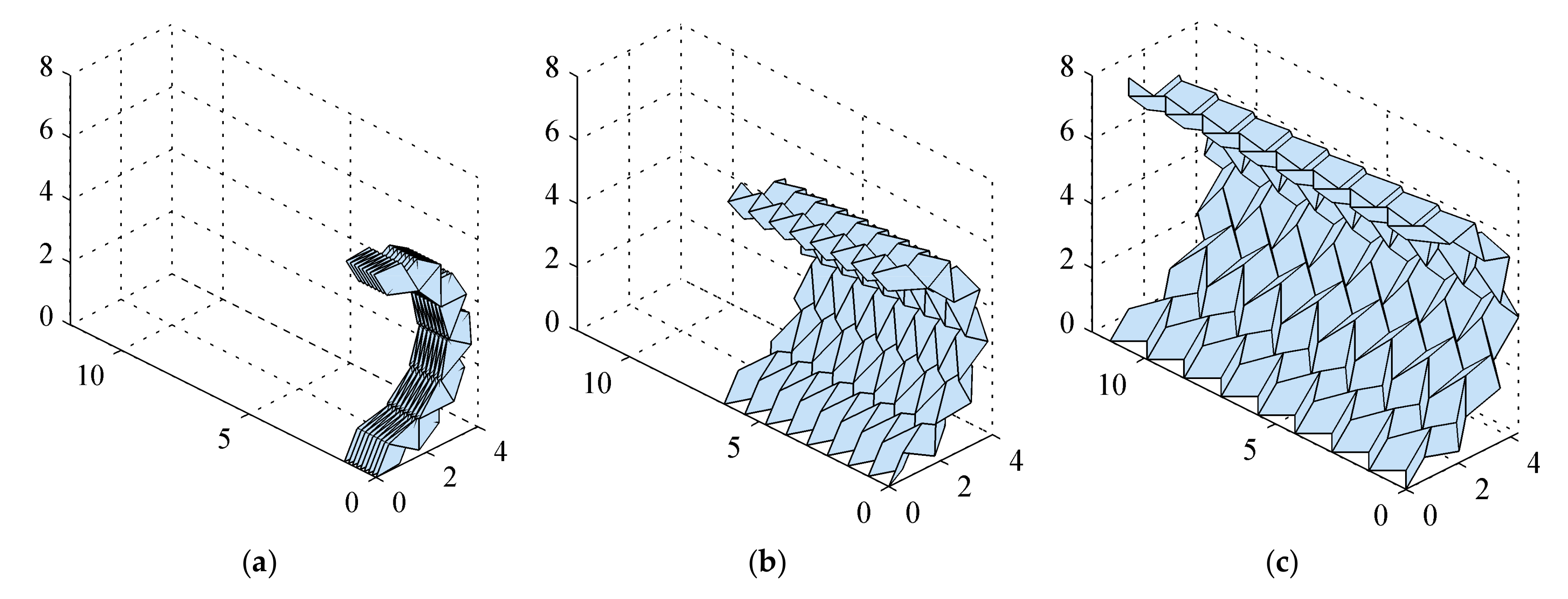
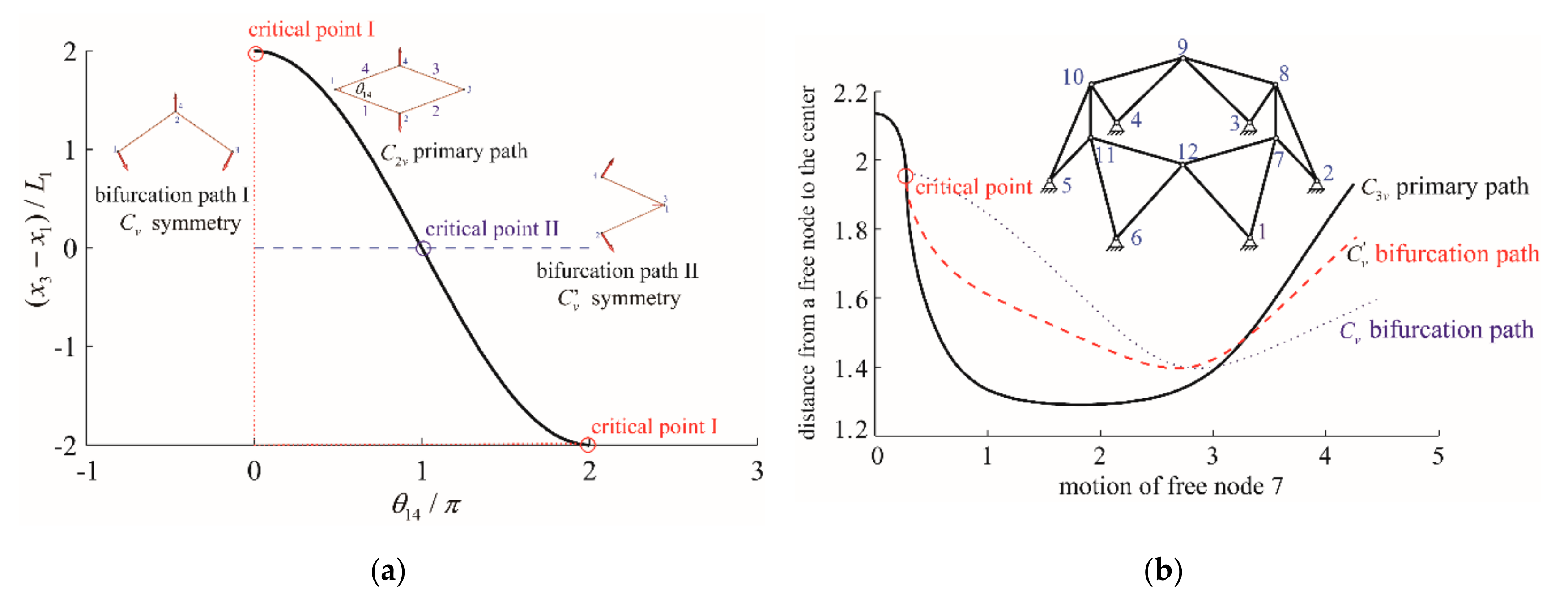
© 2019 by the authors. Licensee MDPI, Basel, Switzerland. This article is an open access article distributed under the terms and conditions of the Creative Commons Attribution (CC BY) license (http://creativecommons.org/licenses/by/4.0/).
Share and Cite
Chen, Y.; Yan, J.; Feng, J. Geometric and Kinematic Analyses and Novel Characteristics of Origami-Inspired Structures. Symmetry 2019, 11, 1101. https://doi.org/10.3390/sym11091101
Chen Y, Yan J, Feng J. Geometric and Kinematic Analyses and Novel Characteristics of Origami-Inspired Structures. Symmetry. 2019; 11(9):1101. https://doi.org/10.3390/sym11091101
Chicago/Turabian StyleChen, Yao, Jiayi Yan, and Jian Feng. 2019. "Geometric and Kinematic Analyses and Novel Characteristics of Origami-Inspired Structures" Symmetry 11, no. 9: 1101. https://doi.org/10.3390/sym11091101
APA StyleChen, Y., Yan, J., & Feng, J. (2019). Geometric and Kinematic Analyses and Novel Characteristics of Origami-Inspired Structures. Symmetry, 11(9), 1101. https://doi.org/10.3390/sym11091101





